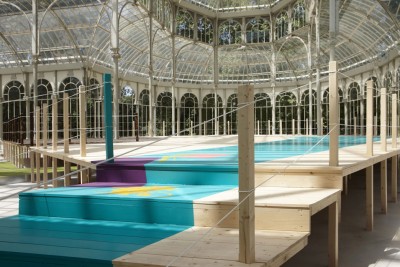Posts archive: September 2010

At Madrid’s Cristal Palace located in the Retiro Park, Jessica Stockholder’s “Peer out to See” pleasantly occupies most of the structure in a balanced and engaging way. Riffing on the the location of the Palace next to a small pond, she has constructed a wooden platform (a “pier,” the first of many puns) that extends into the building. This is flanked on one side by a color-coordinated column of plastic household goods (unfortunately not the kind found at Pier One) and on the other by a star-shaped pool of green duckweed and a circle of orange pigment. On material terms, the piece easily shows Stockholder’s long and assured practice: everything contains a confidence of proportion, color, and weight. The piece occupies and alters the space without overwhelming it, and the space of the viewer’s movement within it seems both natural and well-considered. It takes advantage of both the light and lightness of the space to to provide an engaging experiece. As successful as it is, I did have the nagging sensation that the situation of walking the plank more could have had clearer (and possibly deeper) implications than what is found here. But perhaps that doubt is a measure of the work’s success. Maybe Stockholder is gently observing that we are always in danger of falling off the edge of the platform, the beauty of its surroundings is no barrier to the proximity of the dropoff.
As I left the building I came across several children tossing pieces of bread to several large fish, turtles, ducks, and a pair of black swans (indeed it appears that the entire ecosystem of the pond now depends on the kindness of small children). It was a reminder that in contrast to all the light and possibilities of lightness in “Peer Out to See,” the implications of two black swans hard by a crystal palace is something that no stockholder would wish to explore.
At the Caixa Photo Prize exhibition at the Caixa Forum in Madrid Emilio Morenatti’s winning entry is a set of portraits of Pakistani women who have deformed faces as the result of acid attacks. Though the images (and the stories that accompany them) are horrifying, their formal portraiture portrays the women with a dignity that their attackers would wish to deny. While most of the work on view from ten photographers depicts extreme poverty or situations of institutional violence, the photos share a moderate to high-gloss aesthetic - even Walter Astrada’s images of post-election violence in Kenya share the same color balance qualities of National Geographic. Only Mikel Aristregi’s photos of life among the alcoholic vagrants of Mongolia’s capital Ulan Bator occasionally present their subjects in a flatter light.
Staff at the exhibition said that the catalog sales for this annual exhibition are normally slow. But this year, with a stoic, acid-etched face staring out from its cover and many more contained within, the catalog has proved to be a surprise hit. While aestheticized images of violence make for a wider audience and more palatable viewing, I was left wondering what gripping but graphic photos didn’t make the cut because they weren’t photographic enough.
From the editors
Authors from Posts
- Allegra Fortunati
- Amar Chaudhary
- amy berk
- Asha Schechter
- Aude de Bourbon
- Berin Golonu
- Charles Linder
- Cheryl Meeker
- Dale Hoyt
- David Lawrence
- Diana Gaston
- Ed Osborn
- Elise Barclay
- Ella Delaney
- Glen Helfand
- Gloria Tanchelev
- Happy D
- Jeannine McDonald
- Julie Deamer
- Mark Van Proyen
- Megan Wilson
- Meredith Tromble
- Natalie Welch
- Terri Cohn
- Tucker Nichols
Archived Posts
- December, 2015
- October, 2015
- September, 2015
- July, 2013
- May, 2013
- April, 2013
- March, 2013
- August, 2012
- June, 2012
- March, 2012
- February, 2012
- January, 2012
- December, 2011
- October, 2011
- September, 2011
- July, 2011
- April, 2011
- March, 2011
- February, 2011
- January, 2011
- December, 2010
- November, 2010
- October, 2010
- September, 2010
- August, 2010
- July, 2010
- June, 2010
- April, 2010
- March, 2010
- February, 2010
- January, 2010
- December, 2009
- November, 2009
- October, 2009
- September, 2009
- August, 2009
- July, 2009
- June, 2009
- May, 2009
- April, 2009
- February, 2009
- January, 2009
- December, 2008
- November, 2008
- October, 2008
- September, 2008
- August, 2008
- July, 2008
- June, 2008
- May, 2008
- April, 2008
- March, 2008
- February, 2008
- December, 2007
- November, 2007
- October, 2007
- September, 2007
- August, 2007
- June, 2007
- May, 2007
- April, 2007
- March, 2007
- February, 2007
- January, 2007
- December, 2006
- November, 2006
- October, 2006
- September, 2006
- August, 2006
- July, 2006
- June, 2006
- May, 2006
- April, 2006
- March, 2006
- February, 2006
- January, 2006
- December, 2005
- November, 2005
- October, 2005
- September, 2005
- August, 2005
- July, 2005
- June, 2005
- May, 2005
- March, 2005
- February, 2005
- January, 2005
- December, 2004
- November, 2004
- October, 2004
- September, 2004
- August, 2004
- July, 2004
- June, 2004
- May, 2004
- April, 2004
- March, 2004
- February, 2004
- January, 2004
- December, 2003
- November, 2003
- October, 2003
- September, 2003
- August, 2003
- July, 2003
- June, 2003
- May, 2003
- April, 2003
- March, 2003
- February, 2003
- January, 2003
- December, 2002
- November, 2002
- October, 2002
- September, 2002
- August, 2002
- July, 2002
- June, 2002
- May, 2002
- April, 2002
- March, 2002
- February, 2002
- January, 2002
- December, 2001
- November, 2001
- October, 2001
